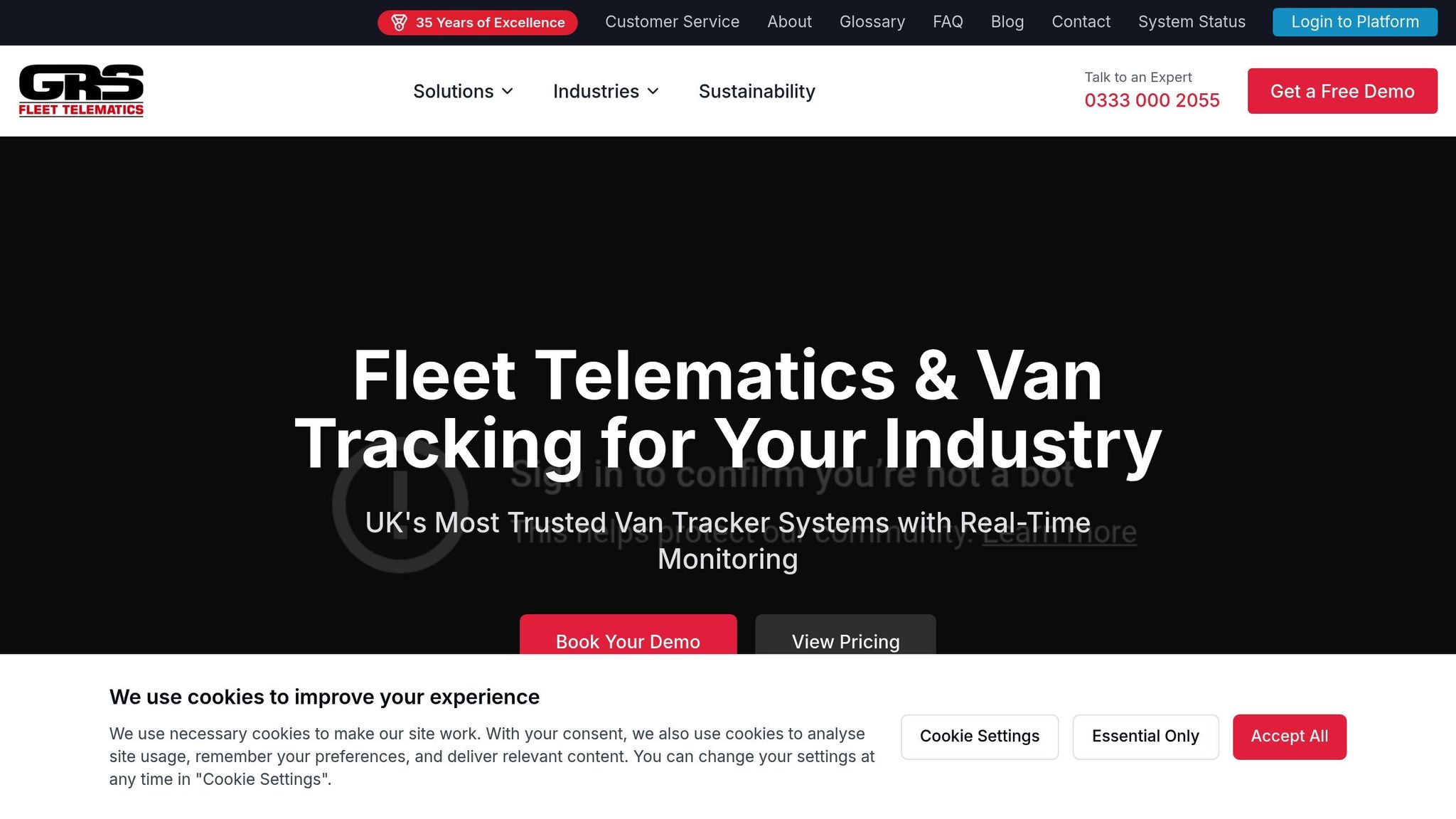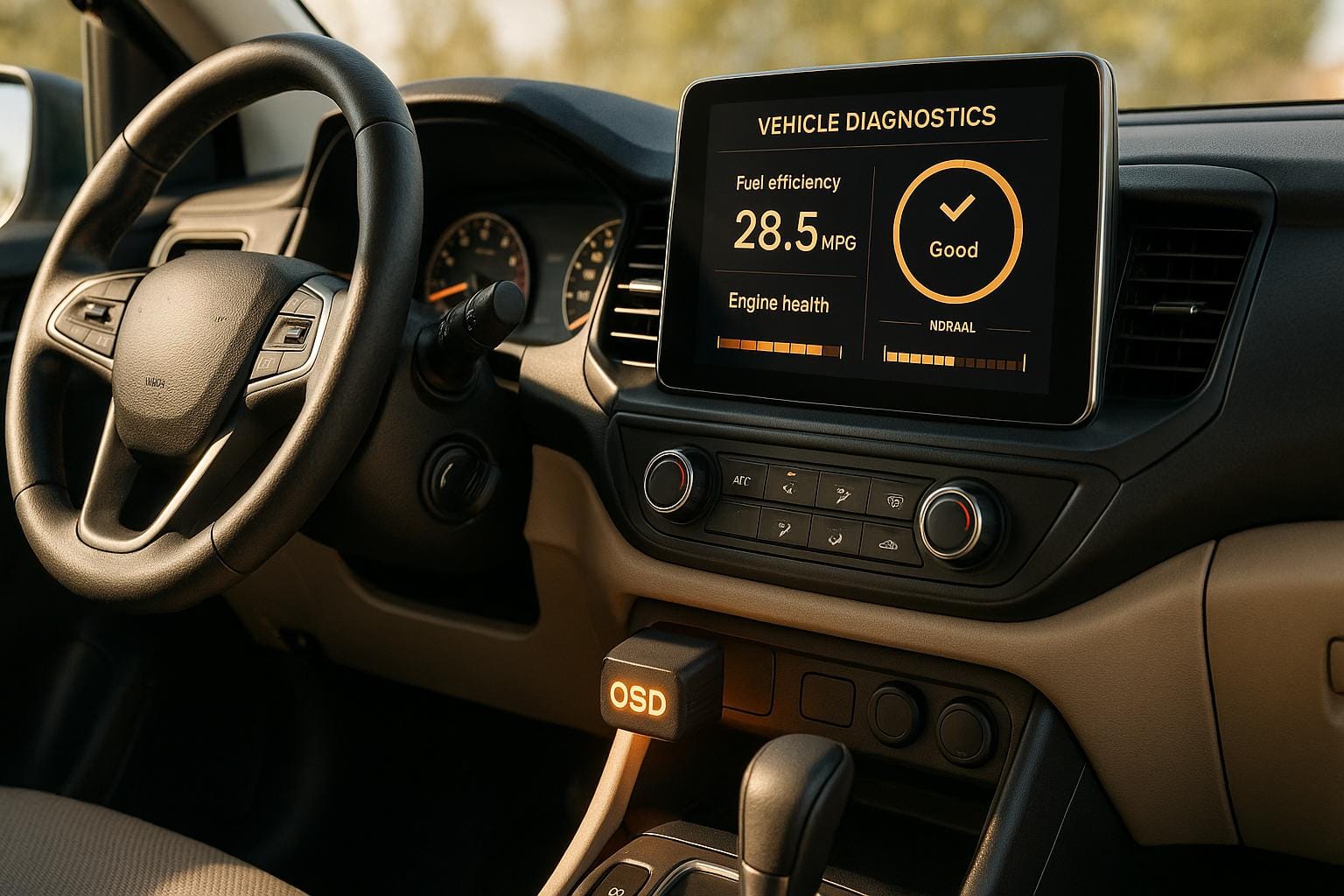OBD devices, or On-Board Diagnostics systems, are small tools that connect to a vehicle's OBD-II port (standard in UK vehicles since 2001) to monitor engine performance, fuel efficiency, and overall vehicle health. These devices are widely used in fleet telematics to collect real-time data on vehicle location, driver behaviour, and mechanical conditions, helping fleet managers streamline operations, reduce costs, and maintain compliance with UK regulations.
Key Features of OBD Devices:
- Vehicle Monitoring: Tracks fuel usage, engine temperature, emissions, and more.
- Diagnostics: Logs Diagnostic Trouble Codes (DTCs) and alerts for potential issues.
- Real-Time Data: Sends updates to cloud platforms via 4G/5G for instant access.
- Integration: Works with GPS systems for route optimisation and security.
- Plug-and-Play Installation: Simple setup with compatibility across most modern vehicles.
Benefits for UK Fleet Operations:
- Compliance: Helps meet MOT and emissions standards, including ULEZ requirements.
- Maintenance: Enables data-driven servicing based on actual vehicle conditions.
- Driver Safety: Tracks behaviours like speeding or harsh braking for training purposes.
- Security: Detects unusual activity and supports geofencing for theft prevention.
While OBD devices are easy to install and cost-effective, they may face issues like tampering, limited compatibility with older vehicles, and reliance on accurate vehicle sensors. However, when combined with telematics systems, they provide fleet managers with actionable insights to improve efficiency and safety.
Main Functions of OBD Devices in Fleet Telematics
Vehicle Health Monitoring and Diagnostics
OBD devices tap into the OBD-II system to provide instant insights into a vehicle's health. The Engine Control Unit (ECU) gathers data from various sensors spread across the vehicle, continuously monitoring critical parameters like engine temperature, fuel injection, and emissions.
When something goes wrong, the ECU logs Diagnostic Trouble Codes (DTCs) and activates the Malfunction Indicator Light (MIL) - commonly known as the "check engine" light. This system ensures that issues are flagged early, allowing fleet managers to remotely diagnose vehicle conditions and address problems before they escalate.
Real-Time Data Collection
OBD devices don’t just focus on fault codes - they also deliver a wealth of real-time data, including engine speed (RPM), fuel consumption, fuel levels, and emissions. Using cellular connectivity, this information is sent to cloud systems, giving fleet managers the ability to monitor vehicle performance as it happens. By analysing this data, managers can spot potential issues, optimise maintenance schedules, and base servicing decisions on actual vehicle usage rather than generic timelines.
Integration with Other Telematics Systems
The diagnostics and real-time data from OBD devices work hand-in-hand with other telematics tools. For instance, when paired with GPS tracking, OBD data can be linked to driving routes and road conditions, helping to optimise routes and minimise wear and tear on vehicles. Additionally, integrating OBD data with cloud-based platforms allows for the creation of intuitive dashboards and automated alerts, offering a clear and comprehensive view of each vehicle's performance. This interconnected system supports predictive maintenance, reduces downtime, and ensures repairs are planned efficiently.
How OBD Devices Work in Vehicle Tracking and Diagnostics
Installation Process
Installing an OBD device is straightforward and doesn’t require technical expertise. The OBD-II port, which has been standard on all vehicles in the UK since 2001, is usually found under the dashboard on the driver’s side. Plugging the device into this port allows it to start communicating with the vehicle’s onboard systems instantly.
Thanks to its plug-and-play design, fleet managers can roll out these devices across their fleet without causing any downtime. Most OBD devices draw power directly from the vehicle’s electrical system, so there’s no need for separate batteries or charging.
This simplicity is particularly beneficial for UK fleet operators managing a mix of vehicle types. Whether it’s a Ford Transit, Mercedes Sprinter, or Volkswagen Crafter, the same OBD device works across the board. This universal compatibility makes training staff and managing inventory much easier, streamlining fleet operations and enabling real-time vehicle monitoring.
Data Transmission and Reporting
Once installed, the devices begin transmitting data immediately. They communicate with the vehicle’s ECU every few seconds, collecting key information such as engine temperature, fuel consumption, and diagnostic codes. This data is then sent via 4G or 5G to a cloud platform.
Thanks to cellular connectivity, fleet managers can access this data in real time, no matter where the vehicle is in the UK. If connectivity is temporarily lost, the device stores the data locally and transmits it once the connection is restored. This ensures that critical updates - like sudden engine faults or unauthorised vehicle movements - are never missed. Real-time updates play a vital role in monitoring vehicle performance and ensuring safety.
The frequency of these updates can often be adjusted based on the fleet’s needs. For high-priority operations, updates might be sent every 30 seconds, while others may prefer minute-by-minute reporting to balance detail with cellular data costs.
UK Data Formats and Measurements
OBD devices are designed to present data in formats familiar to UK fleet operators, making it easier to interpret and comply with local standards. Measurements are displayed in UK-friendly units: distances in kilometres or miles, fuel consumption in litres per 100 km or mpg, temperatures in Celsius, engine speeds in RPM, and time in the 24-hour format.
Speed data is converted to miles per hour, which is essential for monitoring compliance with UK speed limits. Alerts are triggered when vehicles exceed limits, whether it’s the 70 mph cap on motorways or 30 mph in urban areas. Fuel levels are shown as percentages and estimated litres remaining, helping fleet managers plan refuelling stops and track consumption trends.
Additionally, maintenance schedules are simplified with odometer readings in miles and service intervals calculated accordingly. This localisation of data reduces the need for manual conversions, minimising errors and improving operational efficiency. Fleet managers can use this precise data to schedule maintenance effectively and ensure compliance with UK regulations.
Benefits and Drawbacks of OBD Devices in Fleet Management
Benefits of OBD Devices
OBD devices are easy to install, connecting directly via the standard OBD-II port. This plug-and-play setup ensures quick deployment with minimal disruption to daily operations. Compared to hardwired telematics systems, they also come with a lower initial cost, making them a viable option for fleets of all sizes.
These devices provide a wealth of data, offering fleet managers valuable insights into vehicle performance. They can track engine temperature, fuel usage, diagnostic trouble codes, and even driving habits. This detailed information supports proactive maintenance planning, helping to reduce the risk of expensive breakdowns.
Another advantage is real-time monitoring. Fleet managers can stay updated on vehicle status throughout the day, and real-time alerts allow quick responses to urgent issues.
Drawbacks of OBD Devices
Despite their convenience, OBD devices have some limitations. One notable concern is their susceptibility to tampering. Drivers can easily disconnect these devices, which could compromise data accuracy and fleet security.
Compatibility is another issue. Older vehicles or specialised equipment may not fully support OBD devices, leading to incomplete data or the need for alternative hardware solutions.
Data reliability can also be affected. Since OBD devices rely on the vehicle’s sensors, any malfunction in those sensors can result in inaccurate data reporting.
Lastly, while the upfront cost is lower, ongoing cellular charges can add to operational expenses, particularly for larger fleets.
Comparison Table
| Aspect | Benefits | Drawbacks |
|---|---|---|
| Installation | Quick and easy; minimal downtime | Can be tampered with or disconnected |
| Cost | Lower initial investment | Ongoing cellular data costs |
| Data Collection | Tracks multiple vehicle parameters | Accuracy depends on the vehicle’s sensors |
| Compatibility | Works well with most modern vehicles | Limited support for older or specialised ones |
| Maintenance | Requires minimal physical upkeep | Tampering may necessitate frequent checks |
| Deployment Speed | Rapid fleet-wide implementation | Alternative solutions needed for some vehicles |
Using OBD Devices in UK Fleet Operations
Fleet Compliance and Maintenance
Fleet operators in the UK face strict safety and emissions regulations, but OBD devices make staying compliant much easier. These devices monitor fault codes and engine performance, sending instant alerts when issues arise. This not only helps maintain MOT compliance but also ensures vehicles remain roadworthy.
Commercial vehicles are also required to keep detailed maintenance records. OBD devices simplify this process by automatically logging engine hours, mileage, and fault codes. These digital records create an audit trail that supports regulatory compliance while cutting down on paperwork.
For fleets operating in Ultra Low Emission Zones (ULEZ) like London, OBD devices are a game-changer. They allow fleet managers to monitor emissions in real time and provide alerts when vehicles approach emission limits. This proactive approach helps avoid costly fines for non-compliance.
When it comes to maintenance, OBD data offers a smarter way to schedule services. Instead of sticking to mileage-based intervals, fleet managers can use real-time data on engine stress, operating conditions, and diagnostics. This approach reduces unnecessary costs and minimises the risk of unexpected breakdowns.
Beyond compliance and maintenance, OBD devices also play a critical role in improving driver safety and protecting vehicles.
Driver Safety and Vehicle Security
OBD devices are not just about keeping vehicles in top shape - they also help keep drivers safe and vehicles secure. By tracking behaviours like harsh acceleration, sudden braking, and excessive idling, these systems can highlight areas where drivers may need additional training. This reduces accident risks and promotes safer driving across the fleet.
Speed monitoring is another key feature. With speed limits in the UK ranging from 20 mph in residential areas to 70 mph on motorways, OBD devices can alert drivers when they exceed preset limits. These instant notifications help prevent speeding and lower the likelihood of accidents.
Vehicle security gets a boost from OBD integration too. The system can detect unauthorised engine starts, unusual movements, or attempts to tamper with the diagnostic port. Some devices even come with immobilisation features that disable the engine if suspicious activity is detected.
Geofencing adds another layer of security. Fleet managers can set up virtual boundaries around depots, customer sites, or restricted areas. If a vehicle enters or leaves these zones outside of scheduled hours, the system triggers an alert. This can help prevent unauthorised use or theft.
GRS Fleet Telematics Solutions

GRS Fleet Telematics takes OBD technology a step further by combining it with dual-tracker systems for comprehensive fleet monitoring. Their setup includes a primary wired tracker and a secondary Bluetooth backup, ensuring uninterrupted monitoring even if one system is compromised. This robust approach has led to an impressive 91% recovery rate for stolen vehicles.
Their services are available in two packages: the Enhanced package for £79 and the Ultimate package for £99. Monthly subscriptions start at £7.99 per vehicle, covering SIM data, account management, and platform access.
To keep costs manageable, GRS offers free installation when paired with their fleet branding services through GRS Fleet Graphics. They also operate on a pay-per-recovery model, so businesses only pay recovery fees when vehicle recovery services are actually needed.
With 24/7 monitoring and recovery support, GRS ensures fleet operators have help whenever they need it. This is particularly beneficial for businesses managing vehicles across different time zones or operating outside traditional hours. Their integrated approach provides seamless fleet oversight and supports more proactive decision-making.
Webinar | Complete Set of OBD Data Reading | Teltonika

Conclusion
OBD devices play a key role in keeping modern UK fleets running smoothly and safely. By transforming vehicle data into practical insights, they help fleet managers make informed decisions about maintenance, compliance, and security.
These devices gather data that supports smarter maintenance planning, improves safety by tracking driver behaviour, and ensures adherence to UK regulations like MOT standards and ULEZ requirements. When paired with advanced telematics systems, OBD tools offer a complete view of fleet operations, enabling predictive maintenance and cutting operational costs.
GRS Fleet Telematics showcases the potential of OBD technology, combining dual-tracker systems with detailed monitoring services. Their solutions have shown tangible benefits, such as better recovery rates, all while keeping costs manageable with subscriptions starting at £7.99 per vehicle per month.
For fleet operators exploring OBD technology, it represents a practical step towards enhancing fleet efficiency, with the added advantage of reducing downtime and maintenance expenses.
FAQs
How do OBD devices help improve driver safety in fleet management?
OBD devices are a key tool for improving driver safety by offering real-time information on both vehicle performance and driving habits. They help fleet managers spot risky behaviours like harsh braking, sudden acceleration, or prolonged idling, encouraging drivers to adopt safer practices behind the wheel.
These devices also keep an eye on vehicle health, identifying potential mechanical problems early on. This early warning system reduces the chances of breakdowns or accidents, keeping drivers and vehicles safer on the road. By blending behaviour tracking with preventative maintenance, OBD devices play a vital role in creating safer and more reliable fleet operations.
What challenges can arise when using OBD devices in older or specialised fleet vehicles?
Challenges of Using OBD Devices in Older or Specialised Vehicles
Integrating OBD devices into older or specialised vehicles can be tricky. Many of these vehicles rely on outdated or incompatible communication protocols, which can prevent the devices from accessing data or delivering precise diagnostics. On top of that, older vehicles often lack essential sensors, limiting the scope of information the device can collect.
Environmental factors, such as extreme temperatures, and electrical systems not built for continuous device connectivity, can also create issues. These conditions may result in inaccurate readings or even damage the device. For specialised vehicles, the situation becomes more complex, as their unique configurations or non-standard systems can make compatibility a real challenge, reducing the utility of OBD devices for effective tracking and diagnostics.
How do OBD devices work with telematics systems to improve fleet management?
When paired with telematics systems, OBD devices offer invaluable insights into how vehicles are performing and operating. They provide real-time diagnostics on key aspects like engine health, fuel consumption, and emissions. This allows fleet managers to spot potential problems early and address them before they turn into costly repairs or breakdowns.
The integration also plays a crucial role in monitoring driver behaviour and improving route planning. These features help lower fuel expenses, enhance safety, and minimise downtime. Together, these benefits make fleet management across the UK more efficient and economical.

